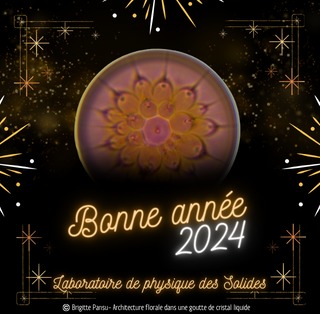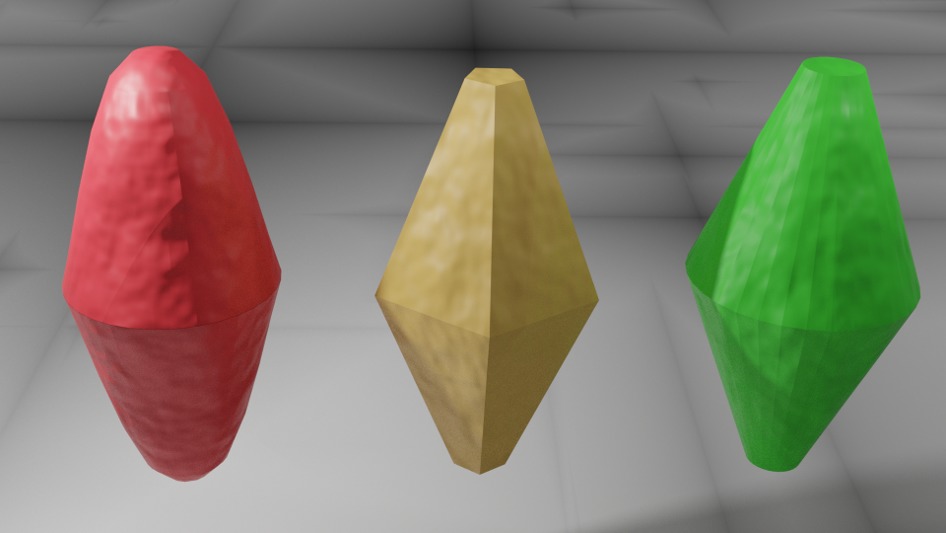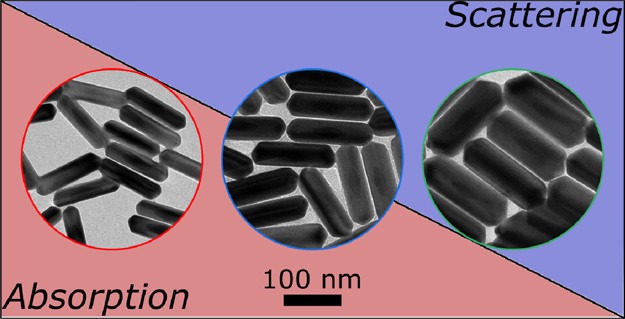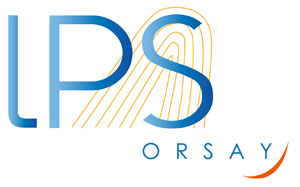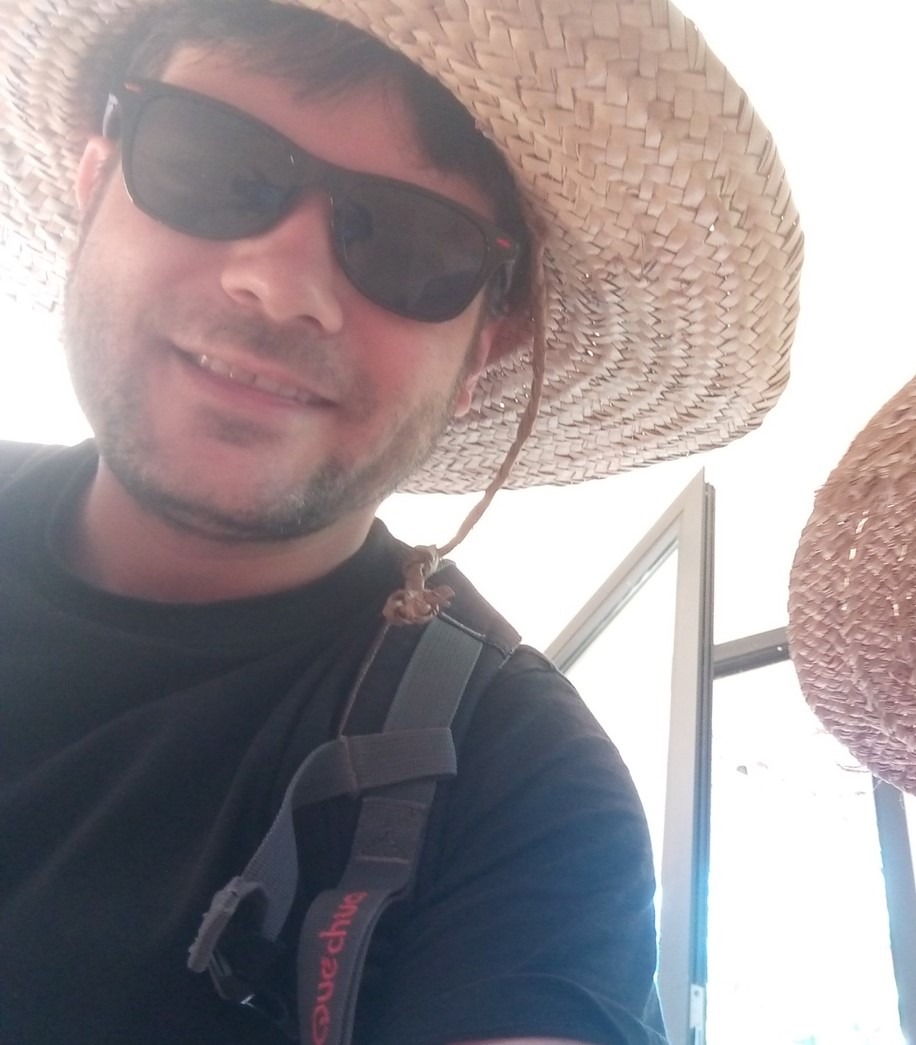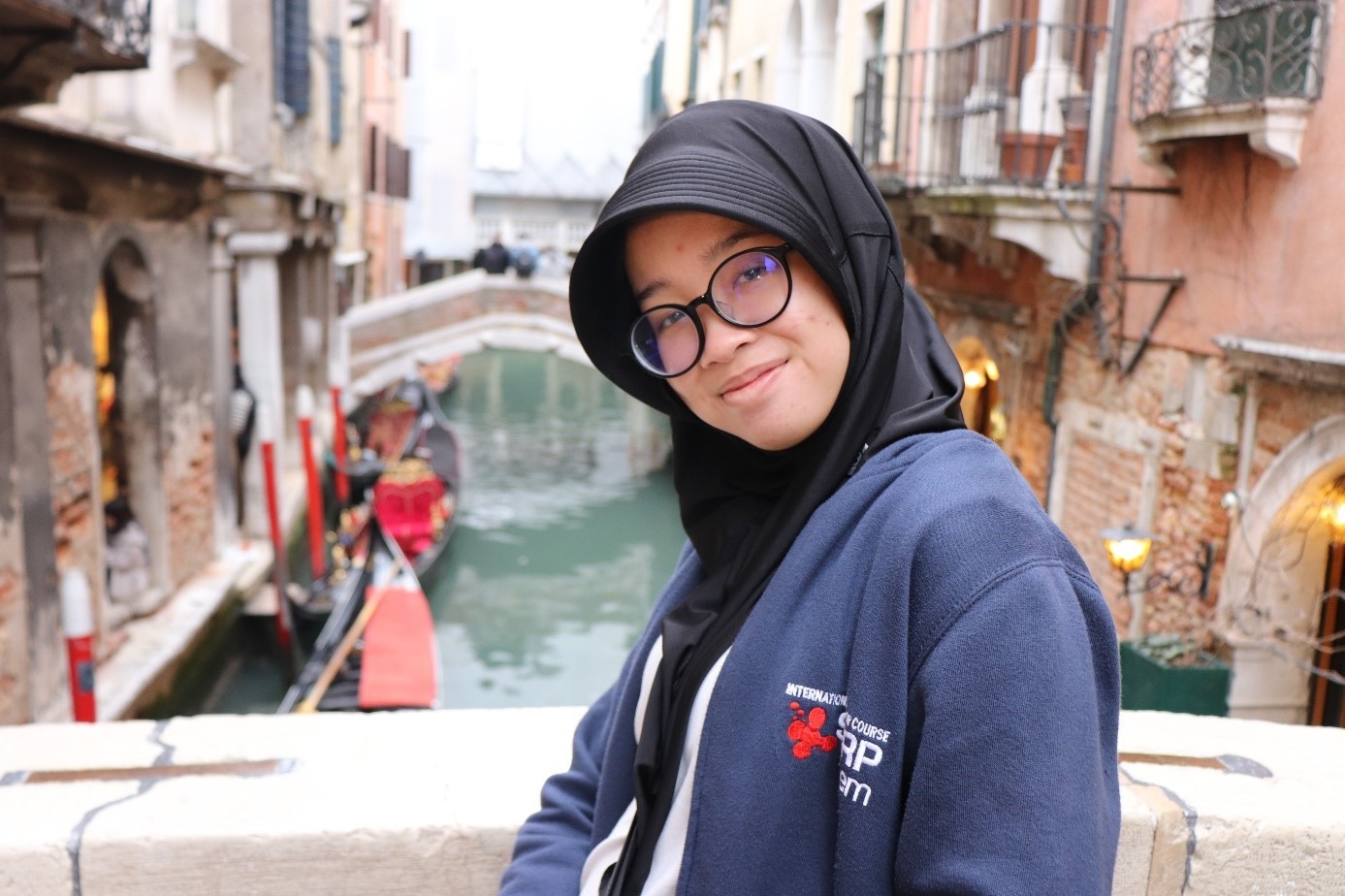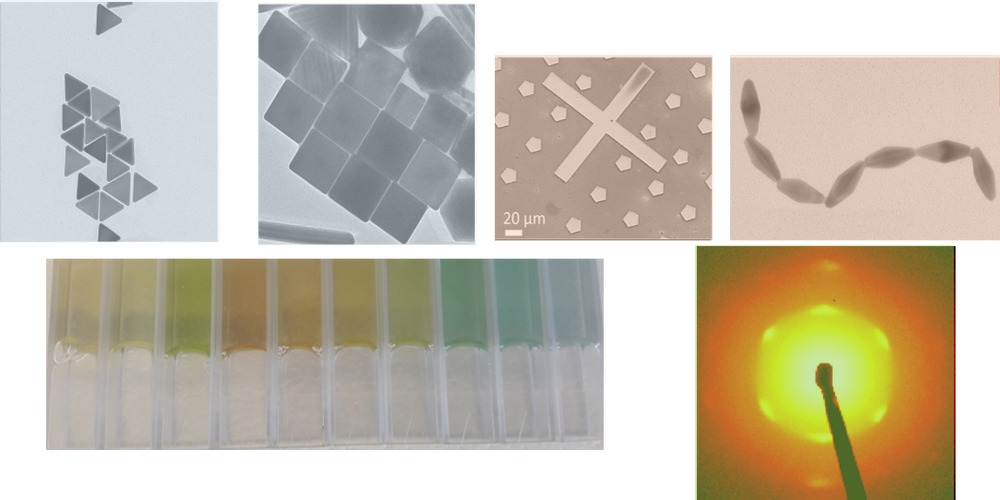

Metamat
We are a team of researchers specialized in nanosciences and we aim at building new materials with enhanced optical and mechanical properties.
Our expertise span from the synthesis of the nanoproducts and their self-assembly to their structural characterization.
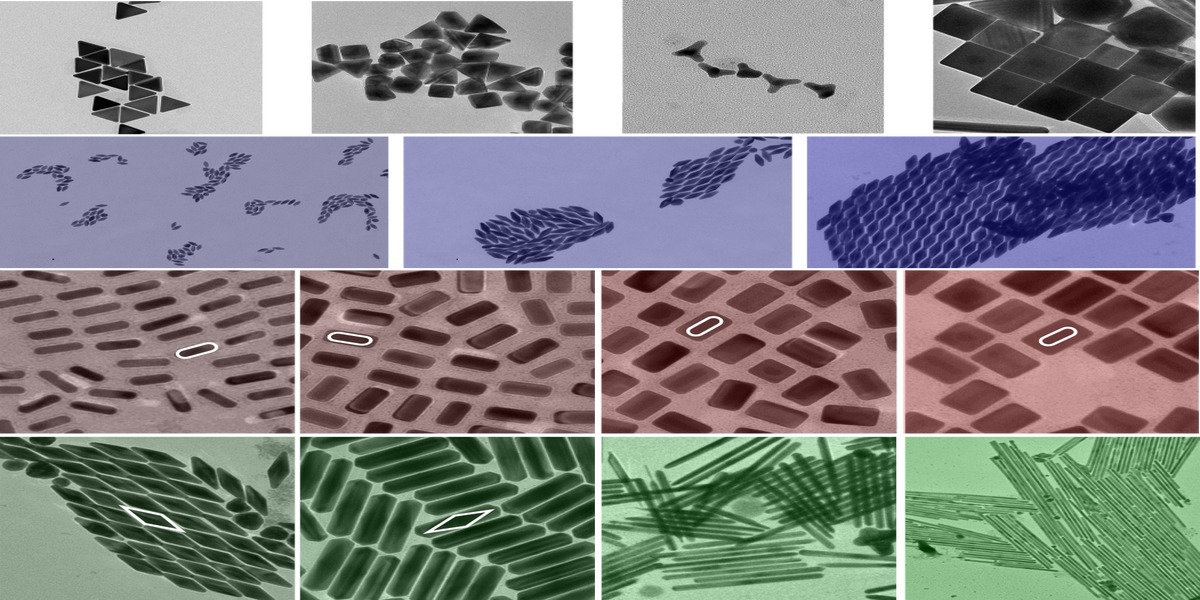
Our latest paper was promoted by CNRS chimie
Our latest paper (DOI : 10.1021/acsnano.3c12799) on prismatic confinement was promoted by CNRS Chimie and LPS:
LPS: https://equipes2.lps.u-psud.fr/matrix/guiding-nanoparticle-assembly-into-complex-structures/
16/04/2024
Prismatic Confinement Induces Tunable Orientation in Plasmonic Supercrystals
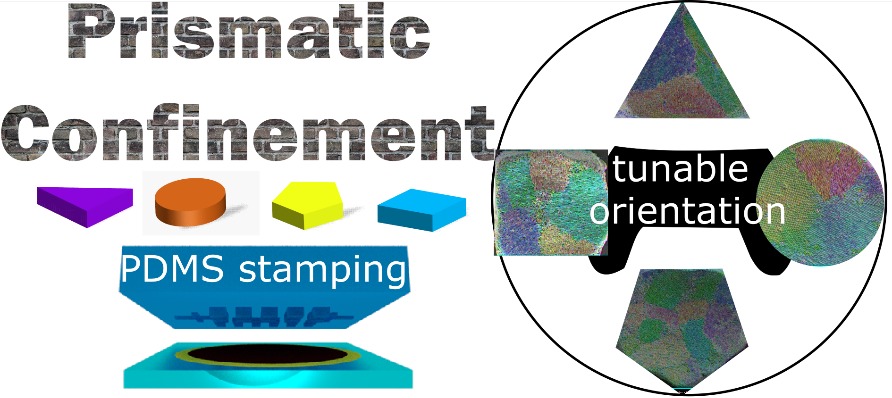 |
21/03/2024 Throughout history, scientists have looked to Nature for inspiration and attempted to replicate the intricate complex structures formed by self-assembly. In the context of synthetic supercrystals, achieving such complexity remains a challenge due to the highly symmetric nature of most nanoparticles (NPs). Previous works have shown intricate coupling between the self-assembly of NPs and confinement in templates such as emulsion droplets (spherical confinement) or tubes (cylindrical confinement). This study focuses on the interplay between anisotropic NP shape and tunable “prismatic confinement” leading to the self-assembly of supercrystals in cavities featuring polygonal cross-sections. A multiscale characterization strategy is employed to investigate the orientation and structure of the supercrystals, locally and at the ensemble level. Our findings highlight the role of the mold interface in guiding the growth of distinct crystal domains: each side of the mold directs the formation of a monodomain that extends until it encounters another, leading to the creation of grain boundaries. Computer simulations in smaller prismatic cavities were conducted to predict the effect of increased confinement. Comparison between prismatic confinement and cylindrical confinement shows that flat interfaces are key to orient the growth of supercrystals. This work shows a method of inducing orientation in plasmonic supercrystals and controlling their textural defects, thus offering insight into the design of functional metasurfaces and hierarchical structured devices. See article @ ACS Nano: DOI: 10.1021/acsnano.3c12799 |
Welcome Nika!
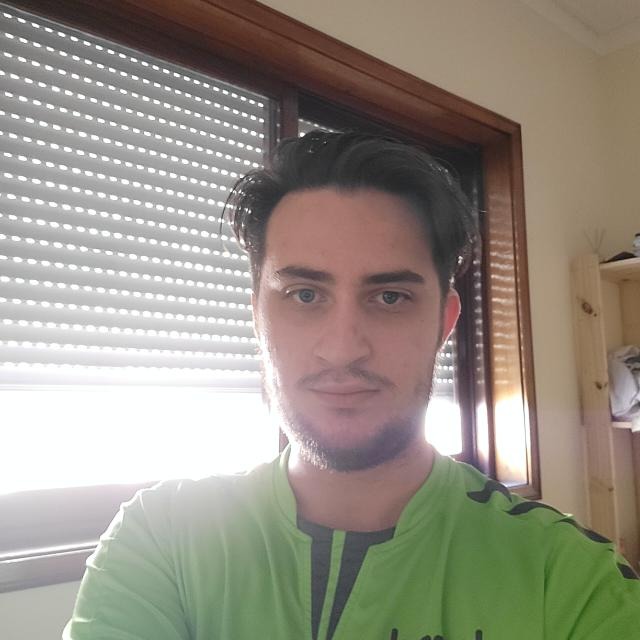 |
01/02/2024 I started thinking about chemistry when I participated in international chemistry Olympiad, (ICHO) 48 where I became fascinated about science. Therefore, I studied chemistry at San Diego State University Georgia and obtained bachelor’s degree there. Then, I decided to divert study direction towards physical chemistry and materials science that is why I applied to SERP master program at Université Paris-Saclay. Currently, I am involved in M2 internship in LPS where I work for the project “Templated Colloidal Crystals with Collective Optical or Magnetic Properties” which is supervised by Dr.Cyrille Hamon and Dr.Marianne Imperor-Clerc.
Currently, I am particularly interested in self-assembly of nanoparticles and how to utilize the properties of nanoparticles in the field of plasmonics/photonics and imaging.
|
Cyrille defended his HDR
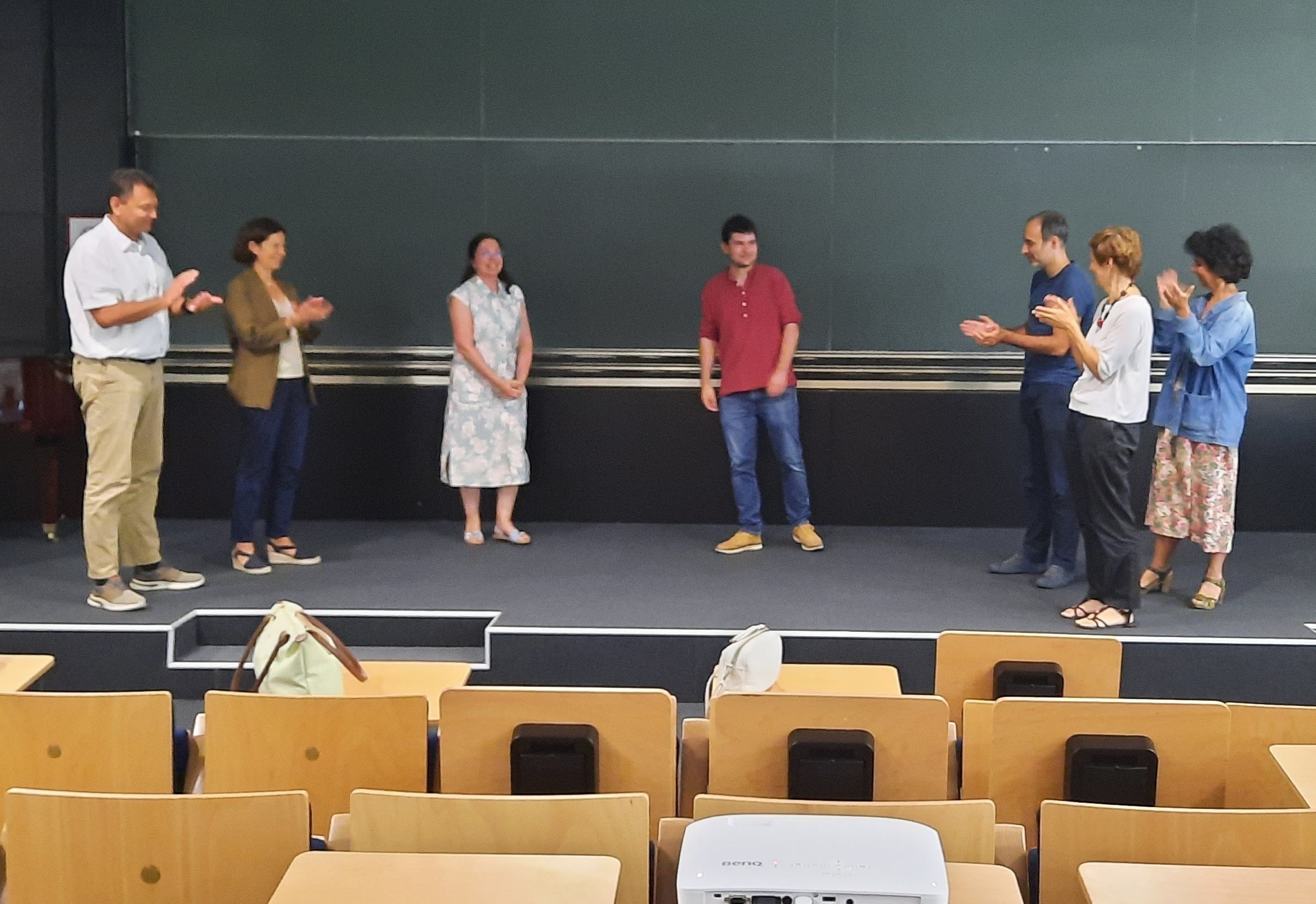 |
07/09/2023 Cyrille succesfully defended his accredidation to supervize research (HDR). Thanks to jury (from left to right): Stéphane Parola (ENS Lyon) Fabienne Testard (CEA Saclay) Hynd Remita (ICP) David Portehault (LCMCP) Mona Tréguer-Delapierre (ICMCB) Emmanuelle Lacaze (INSP) |
Congratulation to the new generation of researchers in the team (note 30/06/23)
Claire, Jules and Rahul got their abstract accepted for oral presentations in famous international conferences to come (NaNax in Austria and ECIS in Italy)
Claire Hotton won the best oral presentation at GFA in Mulhouse (21-23/06/2023)
Jaime Trazo presented well his past achievements and project in the team at ED2MIB doctoral competition and won a PhD grant (05/2023)
Jules Marcone won the best poster price at GDR NINO in Jussieu (14-16/02/2022)
Confinement Effects on the Structure of Entropy-InducedSupercrystals
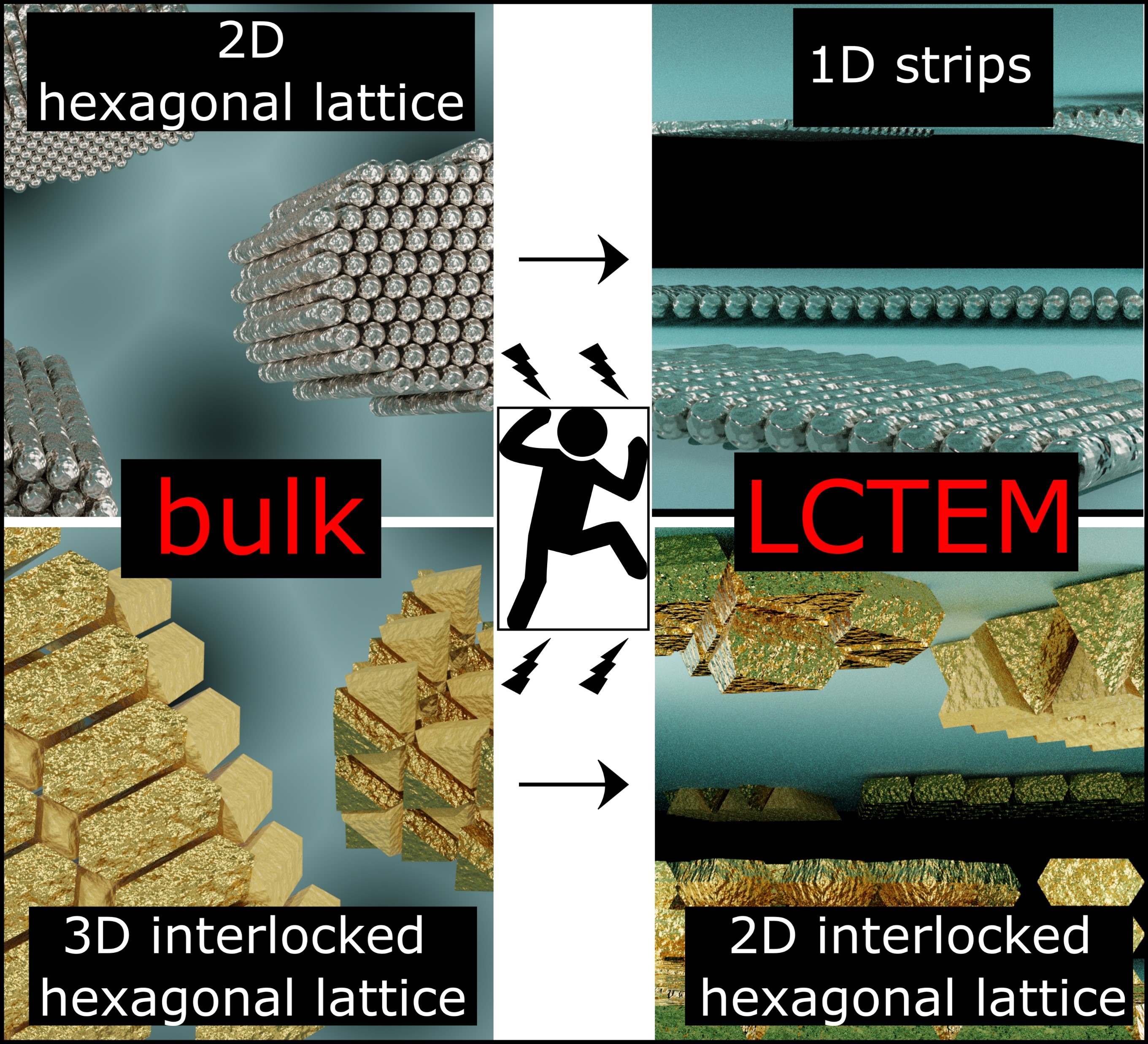 |
30/06/2023 Depletion-induced self-assembly is routinely used to separate plasmonicnanoparticles (NPs) of different shapes, but less often for its ability to createsupercrystals (SCs) in suspension. Therefore, these plasmonic assemblieshave not yet reached a high level of maturity and their in-depthcharacterization by a combination of in situ techniques is still very muchneeded. In this work, gold triangles (AuNTs) and silver nanorods (AgNRs) areassembled by depletion-induced self-assembly. Small Angle X-ray Scattering(SAXS) and scanning electron microscopy (SEM) analysis shows that theAuNTs and AgNRs form 3D and 2D hexagonal lattices in bulk, respectively.The colloidal crystals are also imaged by in situ Liquid-Cell TransmissionElectron Microscopy. Under confinement, the affinity of the NPs for the liquidcell windows reduces their ability to stack perpendicularly to the membraneand lead to SCs with a lower dimensionality than their bulk counterparts.Moreover, extended beam irradiation leads to disassembly of the lattices,which is well described by a model accounting for the desorption kineticshighlighting the key role of the NP-membrane interaction in the structuralproperties of SCs in the liquid-cell. The results shed light on thereconfigurability of NP superlattices obtained by depletion-inducedself-assembly, which can rearrange under confinement. Article open access: https://doi.org/10.1002/smll.202303380 |
Polymorphous packing of pentagonal nanoprisms
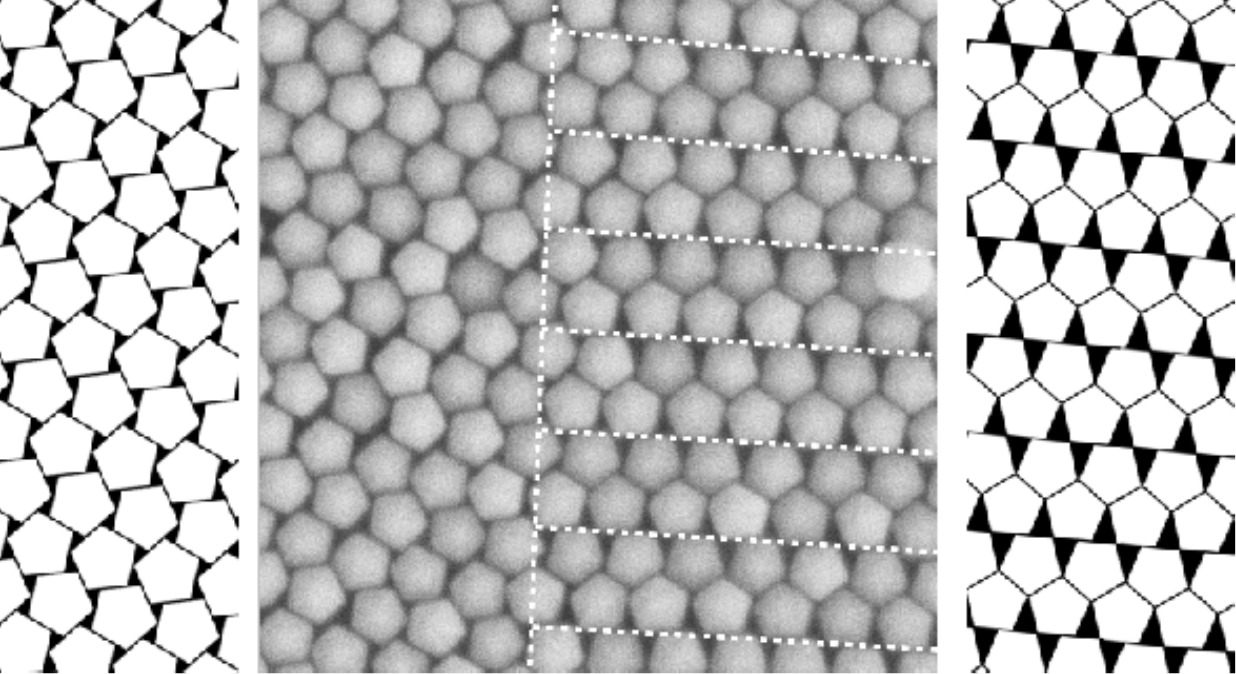 |
11/02/2023 Packing solid shapes into regular lattices can yield very complex assemblies, not all of which achieve the highest packing fraction. In two dimensions, the regular pentagon is paradigmatic, being the simplest shape that does not pave the plane completely. In this work, we demonstrate the packing of plasmonic nanoprisms with pentagonal cross section, which form extended supercrystals. We do encounter the long-predicted ice-ray and Durer packings (with packing fractions of 0.921 and 0.854, respectively), but also a variety of novel polymorphs that can be obtained from these two configurations by a continuous sliding transformation and exhibit an intermediate packing fraction. Beyond the fundamental interest of this result, fine control over the density and symmetry of such plasmonic assemblies opens the perspective of tuning their optical properties, with potential applications in metamaterial fabrication, catalysis or molecular detection. |
Welcome Jaime!
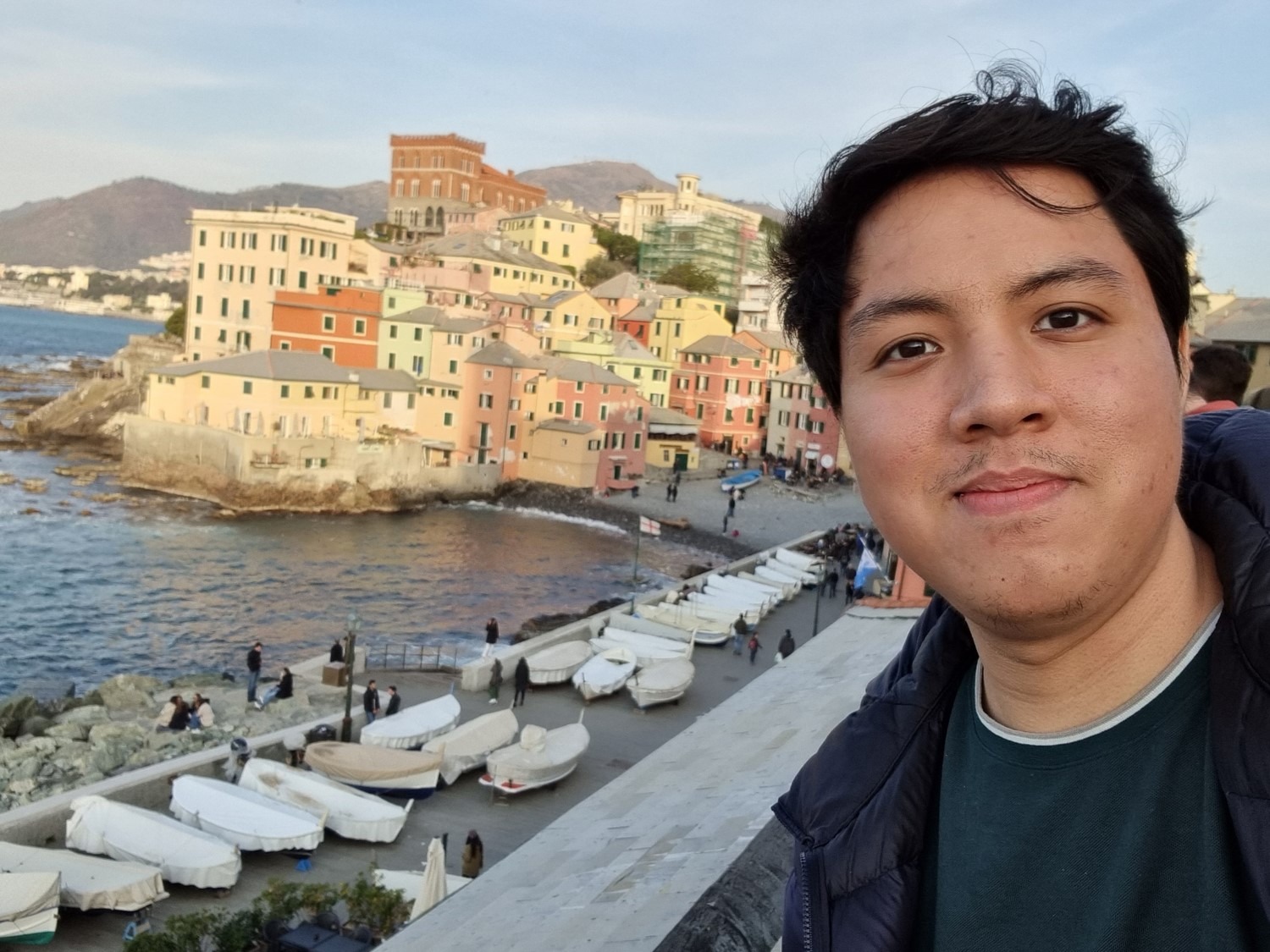 |
03/02/2023
Jaime Gabriel Trazo earned his bachelor degrees in Chemistry and in Materials Science and Engineering at the Ateneo de Manila University (2019, 2020), where he worked on formulating green silver nanoparticle inks for printed electronics and on nanocellulose synthesis, under Dr. Jose Mario Diaz and Dr. Erwin Enriquez. He was also a National Awardee at the BPI-DOST Science Awards 2019 in the Philippines.
He is now pursuing his master’s degree under the Erasmus Mundus SERP+ Program. For his M2 internship, he joined the Laboratoire de Physique des Solides, where he works on the self-assembly of nanoparticles into supercrystals with collective optical/magnetic properties, under Dr. Cyrille Hamon and Dr. Marianne Impéror-Clerc. His current research interests and experience are in the intersection of chemistry and nanomaterials, particularly for plasmonics, electronics, opto-electronics, and energy applications. |
Welcome Rahul!
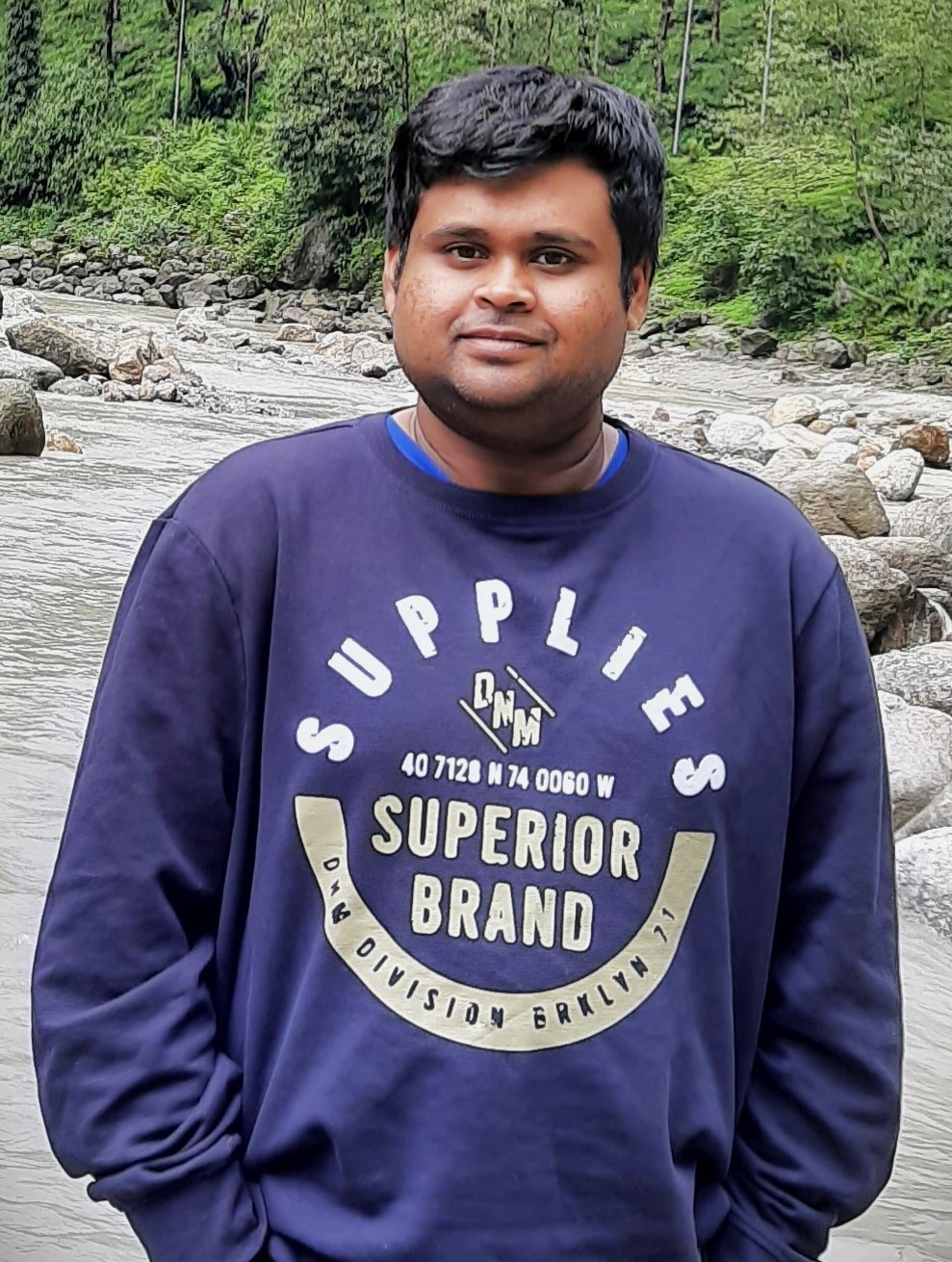 |
02-02-2023 Rahul Nag obtained his PhD from IIT Bombay under the supervision of Chebrolu Pulla Rao in Bio-Inorganic Chemistry Laboratory. He worked on the surface functionalization of nanostructures by organic conjugates specially calixarenes which involved applications in sensing, cancer cell killing, catalysis. He did a one-year post-doctoral research in CBMN/University of Bordeaux under the supervision of Emilie Pouget in the Chiral Molecular Assemblies Group led by Reiko Oda. He is now joining the Laboratoire of Physique des Solides as a postdoctoral researcher with Cyrille Hamon. Currently, his interest focuses on the synthesis of gold nanostructures controlling their shapes and sizes for possible application in non-linear optics. |
Extracting the morphology of gold bipyramids from small-angle X-ray scattering experiments via form
|
|
25/01/2023 Accurate shape description is a challenge in materials science. Small-angle X-ray scattering (SAXS) can provide the shape, size and polydispersity of nanoparticles by form factor modelling. However, simple geometric models such as the ellipsoid may not be enough to describe objects with complex shapes. This work shows that the form factor of gold nanobipyramids is accurately described by a truncated bicone model, which is validated by comparison with transmission electron microscopy (TEM) data for nine different synthesis batches; the average shape parameters (width, height and truncation) and the sample polydispersity are obtained. In contrast, the ellipsoid model yields worse fits of the SAXS data and exhibits systematic discrepancies with the TEM results. |
Happy 2023!
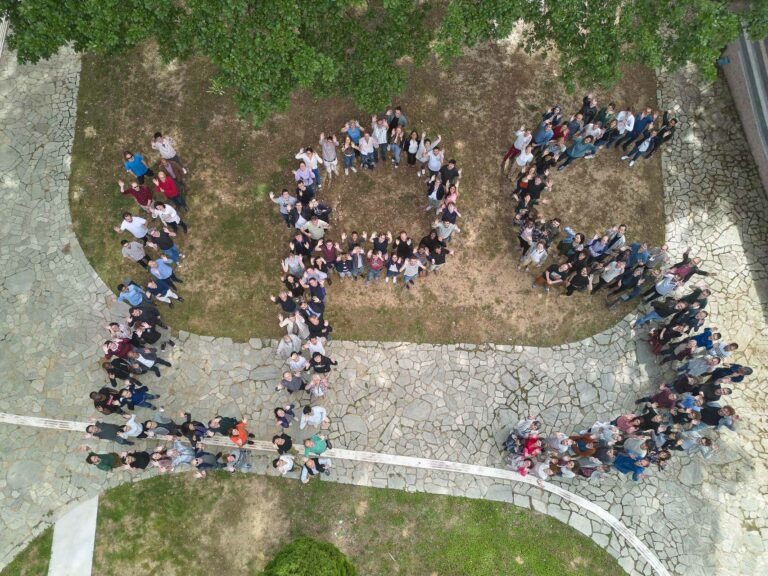
Welcome Jules and Claire!
Jules joined in october as a PhD student and Claire joined in december as a post-doc. Welcome!
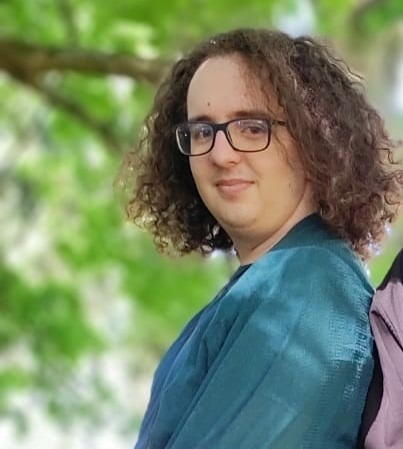 |
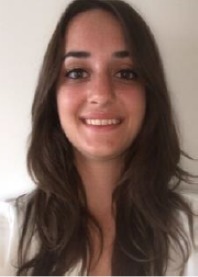 |
21/12/2022
Formation of kinetically trapped small clusters of PEGylated gold nanoparticles revealed by the comb
 |
26/10/2022. Gold nanoparticles coated with polyethylene glycol (PEG) are able to form clusters due to the collapse of the surface-grafted polymer chains when the temperature and ion concentration of the aqueous medium are increased. The chain collapse reduces the steric repulsion, leading to particle aggregation. In this work, we combine small angle X-ray scattering (SAXS) and visible light spectroscopy to elucidate the structure of the developing clusters. The structure derived from the SAXS measurements reveals a decrease in interparticle distance and drastic narrowing of its distribution in the cluster, indicating restricted particle mobility and displacement within the cluster. Surprisingly, instead of forming a large crystalline phase, the evolving clusters are composed of about a dozen particles. The experimental optical extinction spectra measured during cluster formation can be very well reproduced by optical simulations based on the SAXS-derived structural data.
Thanks to Daniel and Andras from the Centre for Energy Research (Budapest, Hungary) for this nice collaboration. |
Longitudinal and Transversal Directed Overgrowth of Pentatwinned Silver Nanorods with Tunable Optica
|
|
07/07/2022 Silver nanorods (AgNRs) with a controllable aspect ratio can be formed by templated growth from pentatwinned seeds. However, it is challenging to control the volume of the AgNRs and their aspect ratio independently because of the selective protection against growth of the lateral facets by halides. Here we demonstrate the preparation of AgNRs with tunable width via the addition of dimethyl sulfoxide (DMSO). AgNRs with custom dimensions were produced by separating the longitudinal and transverse growth in a two-step procedure. In the first step, the length is tuned by directing the overgrowth on the {111} tips of the AgNRs. In the second step, the width is adjusted by directing the overgrowth on the {100} lateral facets in the presence of DMSO. AgNRs of varying dimensions were obtained and characterized by a combination of techniques including scanning transmission electron microscopy, electron energy loss spectroscopy, and cathodoluminescence, which are, respectively, sensitive to the extinction and scattering component of the AgNRs’ response. This method allows tuning the plasmon energies, but also the ratio of the scattering and absorption contributions. |
Jieli presented her PhD
|
05/07/2022 Jieli Lyu successfully presented her PhD after 4 years in the lab under the supervision of Doru, Cyrille and Marianne. It was pointed out that she arrived as a young student and will leave the lab as a young scientist. Congratulation Jieli! |
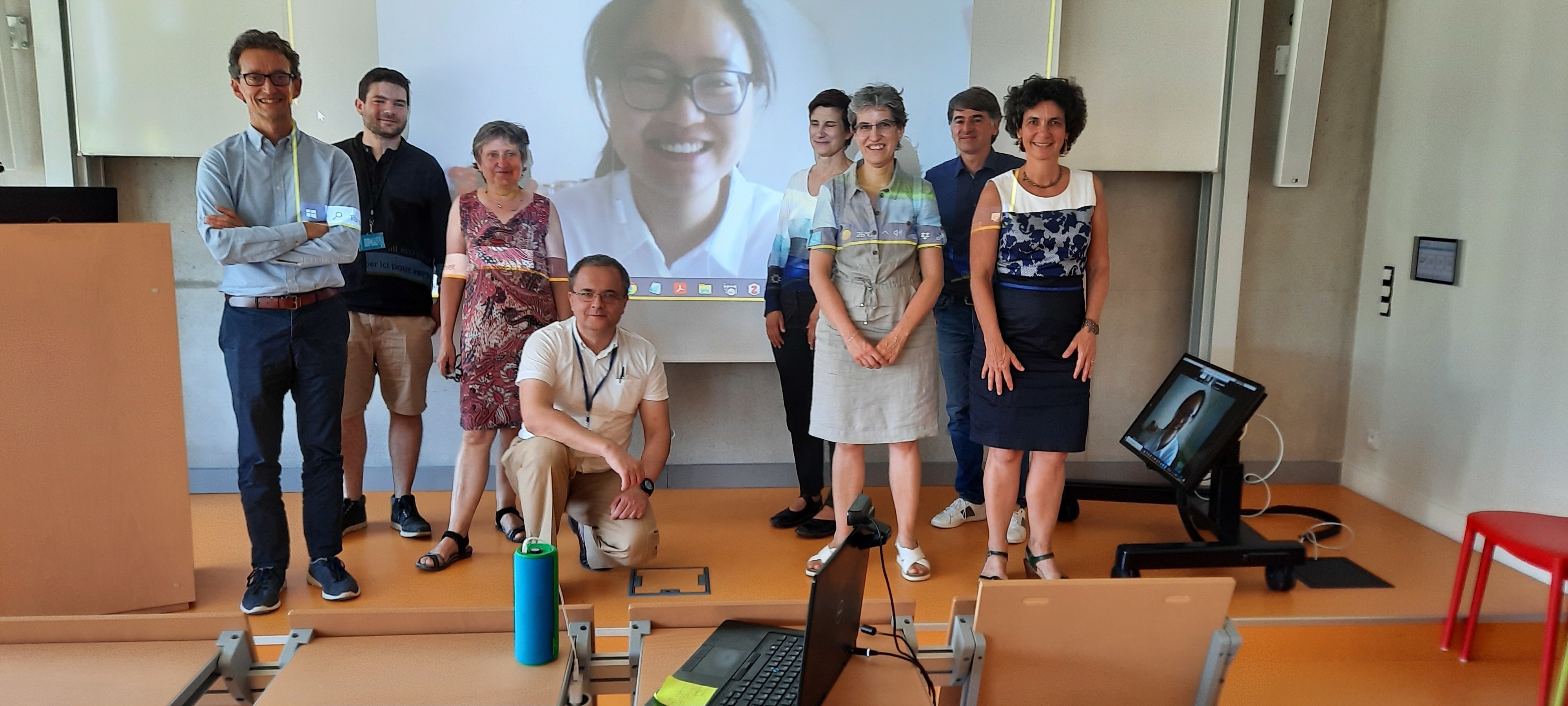 |
Shape-Controlled Second-Harmonic Scattering from Gold Nanotetrapods
 |
02/06/2022 In the search for efficient building blocks for nonlinear metamaterials, plasmonic nanoparticles have received considerable attention. Their quadratic nonlinear optical properties result from a complex interplay between the nature of the bulk material, the object shape, surface defects, and retardation effects. This versatility can be used to tailor the properties of the resulting material. However, despite extensive investigation, separating and controlling these contributions still pose a challenge. In this report, we control the morphology of colloidal gold nanoparticles with tetrahedral symmetry and explore their second harmonic scattering response. The material itself is centrosymmetric but not the shape, conferring to the first hyperpolarizability an almost purely octupolar symmetry. Gradually reshaping the nanoparticles into spheres (and thus decreasing their asymmetry) reduces their nonlinear response, showing that it is controlled by the morphology. These results open the way toward new kinds of nonlinear plasmonics platforms and imaging probes. |
Acoustic Vibration Modes of Gold–Silver Core–Shell Nanoparticles
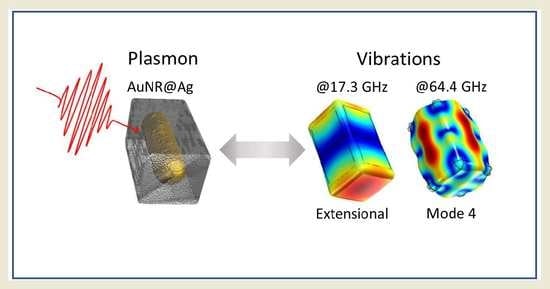 |
30/05/2022 Bimetallic Au/Ag core–shell cuboid nanoparticles (NPs) exhibit a complex plasmonic response dominated by a dipolar longitudinal mode and higher-order transverse modes in the near-UV, which may be exploited for a range of applications. In this paper, we take advantage of the strong signature of these modes in the NP ultrafast transient optical response, measured by pump-probe transient absorption (TA) spectroscopy, to explore the NP vibrational landscape. The fast Fourier transform analysis of the TA dynamics reveals specific vibration modes in the frequency range 15–150 GHz, further studied by numerical simulations based on the finite element method. While bare Au nanorods exhibit extensional and breathing modes, the bimetallic NPs undergo more complex motions, involving the displacement of facets, edges and corners. The amplitude and frequency of these modes are shown to depend on the Ag shell thickness, as the silver load modifies the NP aspect ratio and mass. Moreover, the contributions of the vibrational modes to the experimental TA spectra are shown to vary with the probe laser wavelength at which the signal is monitored. Using the combined simulations of the NP elastic and optical properties, we elucidate this influence by analyzing the effect of the mechanisms involved in the acousto-plasmonic coupling. Thanks to the collaborators for this nice work. https://doi.org/10.3390/chemosensors10050193 |
Laser-Driven Bubble Printing of Plasmonic Nanoparticle Assemblies onto Nonplasmonic Substrates
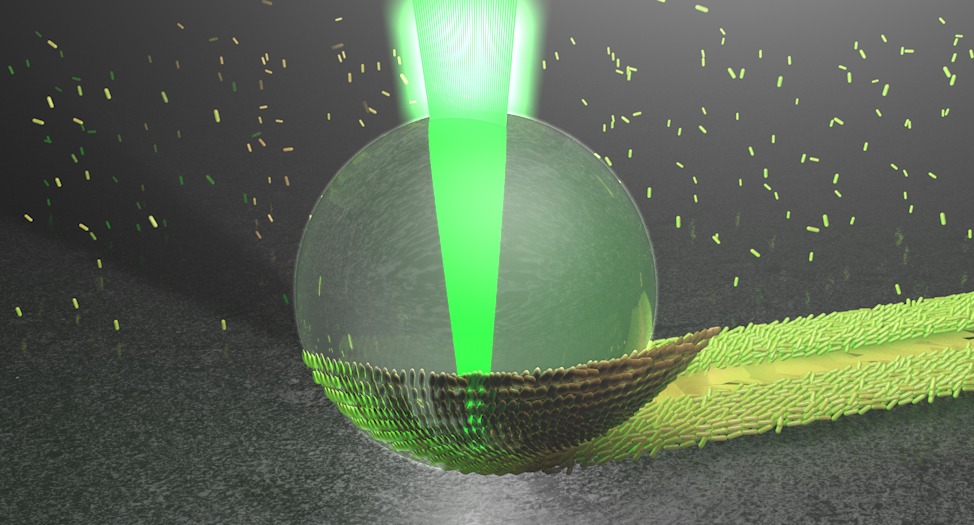 |
28/04/2022 The use of optically controlled vapor bubbles for controlled synthesis and deposition at interfaces is a promising emerging technique, which is intrinsically limited by the ability of the system to provide enough heat for bubble formation that is typically addressed using a plasmonic substrate. Herein, a simple and fast method for laser-controlled printing of plasmonic nanoparticles onto nonplasmonic substrates is shown. The laser fluence needed to print the nanoparticle was lowest for nanoparticles in resonance with the laser wavelength, but the technique is also effective off-resonance. Hierarchical assemblies were obtained, where melting was observed up to a micron from the focal point of the laser beam. The assemblies show plasmonic properties in the unmelted region, as shown by surface-enhanced Raman scattering spectroscopy measurements. This work will lead to future studies on controlling the hierarchical structure of nanoparticle assemblies formed at the bubble interface toward applications in sensing and devices. https://doi.org/10.1021/acs.jpcc.2c02414 Thanks to Eric Hill and his nice microscope for printing plasmonic patterns. |
Double-lattice packing of pentagonal gold bipyramids in supercrystals with triclinic symmetry
24/03/2022
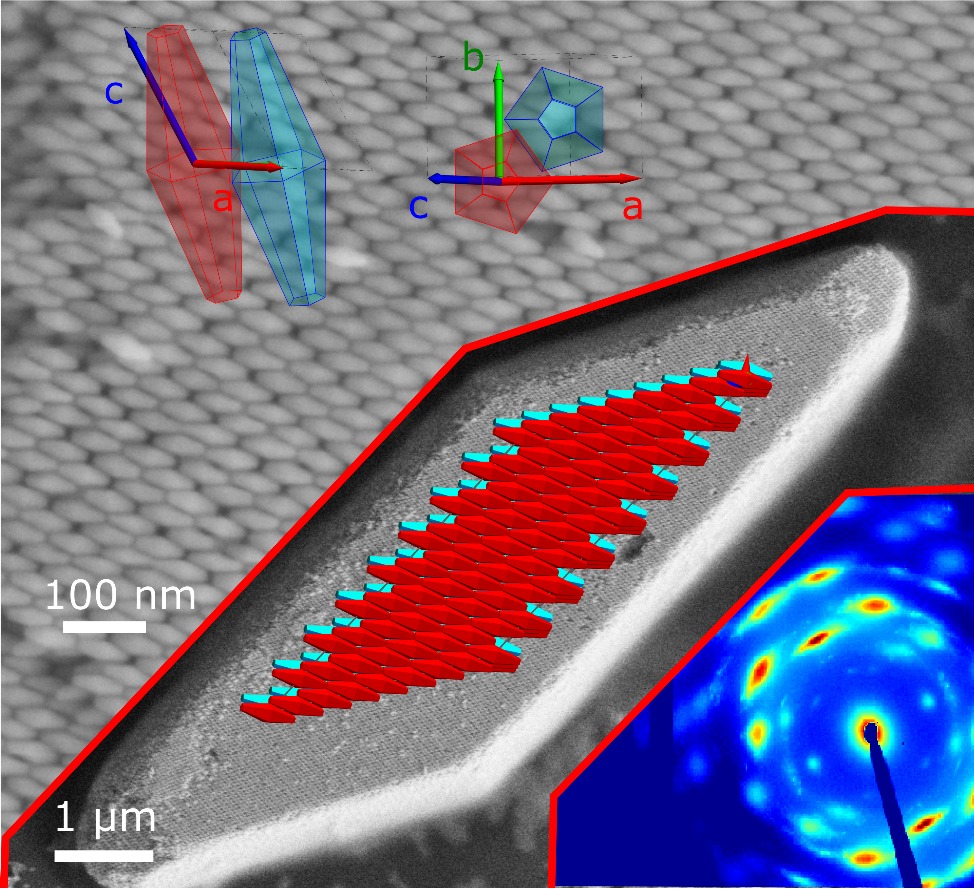 |
Pentagonal packing is a long-standing issue and a rich mathematical topic, brought to the fore by recent progress in nanoparticle design. Gold pentagonal bipyramids combine five-fold symmetry and anisotropy and their section varies along the length. In this work, we obtain colloidal supercrystals of pentagonal gold bipyramids in a compact arrangement that generalizes the optimal packing of regular pentagons in the plane. Multimodal investigations reveal a two-particle unit cell with triclinic symmetry, a lower symmetry than that of the building blocks. Monte Carlo computer simulations show that this lattice achieves the densest possible packing. Going beyond pentagons, further simulations show an odd-even effect of the number of sides on the packing: odd-sided bipyramids are non-centrosymmetric and require the double-lattice arrangement to recover inversion symmetry. The supercrystals display a facet-dependent optical response that is promising for sensing, metamaterials applications and for fundamental studies of self-assembly processes. Press release: CNRS: https://www.inp.cnrs.fr/fr/cnrsinfo/lart-dempiler-des-pyramides |
Welcome Jianan!
28/01/2021
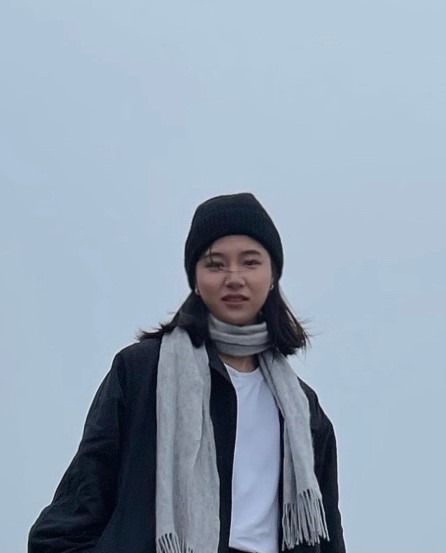 |
I obtained my Bachelor of Engineering in Nano Materials and Technology from Soochow University in China. During my undergraduate study, I worked on several projects related to nanoscaled functional materials for energy conversion and storage under the supervision of Prof. Yanguang Li.
I am now the M2 student from Erasmus Mundus Joint Master program: SERP+. Currently, I am working on my thesis project about self-assembly of colloidal liquid crystal in levitation under the supervision of Dr. Cyrille Hamon and Dr. Erwan Paineau. |
Happy 2022!
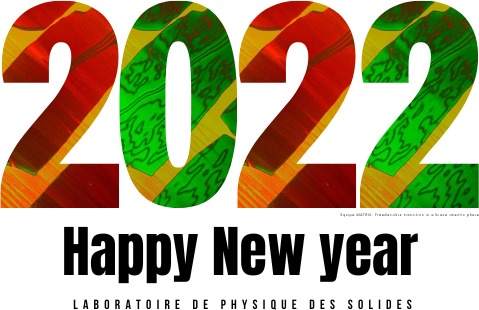
credit photo MATRIX team: Fréedericksz transition in a biaxe smectic phase
Unveiling the Coupling of Single Metallic Nanoparticles to Whispering-Gallery Microcavities
16/12/2021
 |
Nice work published in collaboration with the STEM group @ LPS
10.1021/acs.nanolett.1c03826 Whispering-gallery mode resonators host multiple trapped narrow-band circulating optical resonances that find applications in quantum electrodynamics, optomechanics, and sensing. However, the spherical symmetry and low field leakage of dielectric microspheres make it difficult to probe their high-quality optical modes using far-field radiation. Even so, local field enhancement from metallic nanoparticles (MNPs) coupled to the resonators can interface the optical far field and the bounded cavity modes. In this work, we study the interaction between whispering-gallery modes and MNP surface plasmons with nanometric spatial resolution by using electron-beam spectroscopy with a scanning transmission electron microscope. We show that gallery modes are induced over a selective spectral range of the nanoparticle plasmons, and additionally, their polarization can be controlled by the induced dipole moment of the MNP. Our study demonstrates a viable mechanism to effectively excite high-quality-factor whispering-gallery modes and holds potential for applications in optical sensing and light manipulation. Thanks to the STEM group @ LPS and especially to Yves Auad whom carried out the experiments. |
Gold-clay nanocomposite colloids with liquid-crystalline and plasmonic properties
14/09/2021
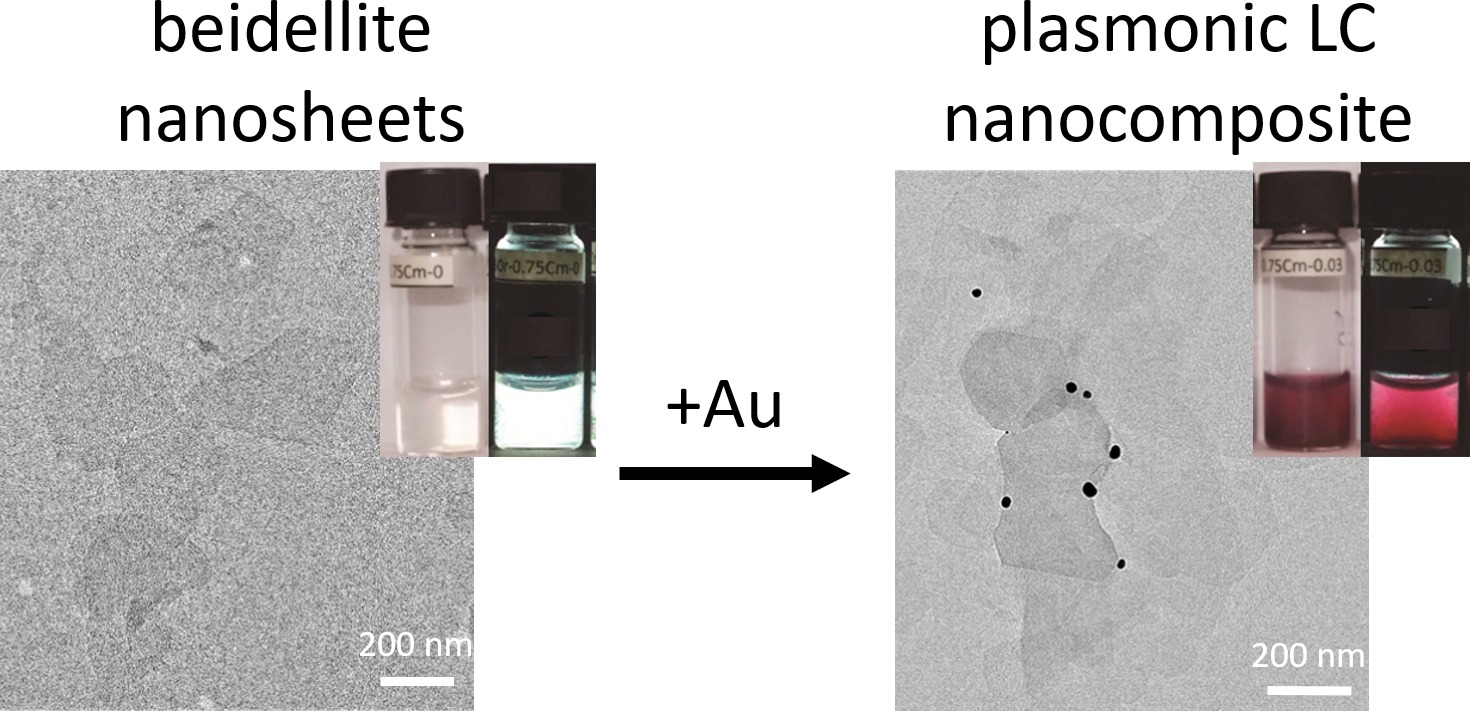 |
Imparting liquid-crystal (LC) materials with the plasmonic properties of metal nanoparticles is actively pursued for applications. We achieved this goal by synthetizing gold nanoparticles onto clay nanosheets, leading to nematic nanocomposite suspensions. Optical observations and structural analysis show the growth of the gold nanoparticles without altering the LC properties of the nanosheets. These colloids display plasmonic structural colours and they can be aligned by an electric field, which is relevant for fundamental and materials chemistry of colloidal LC. |
Doping Liquid Crystals of Colloidal Inorganic Nanotubes by Additive-Free Metal Nanoparticles
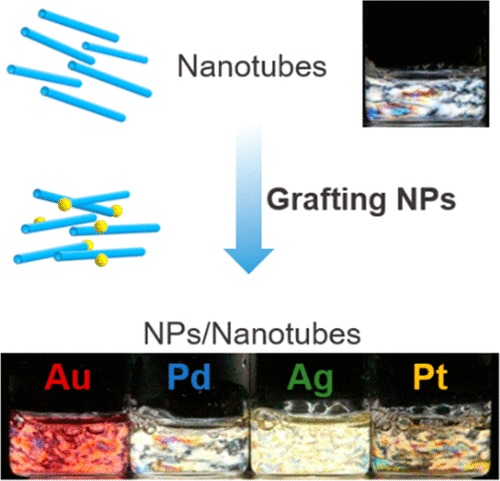 |
25/05/2021 https://doi.org/10.1021/acs.jpclett.1c01311 Doping liquid-crystal phases with nanoparticles is a fast-growing field with potential breakthroughs due to the combination of the properties brought by the two components. One of the main challenges remains the long-term stability of the hybrid system, requiring complex functionalization of the nanoparticles at the expense of their self-assembly properties. Here we demonstrate the successful synthesis of additive-free noble-metal nanoparticles at the surface of charged inorganic nanotubes. Transmission electron microscopy and UV-visible spectroscopy confirm the stabilization of metallic nanoparticles on nanotubes. Meanwhile, the spontaneous formation of liquid-crystals phases induced by the nanotubes is observed, even after surface modification with metallic nanoparticles. Small-angle X-ray scattering experiments reveal that the average interparticle distance in the resulting hybrids can be easily modulated by controlling electrostatic interactions. As a proof-of-concept, we demonstrate the effectiveness of our method for the preparation of homogeneous transparent hybrid films with a high degree of alignment. |
Symmetry breaking in seed-mediated silver nanorod growth induced by dimethyl sulfoxide
12/04/2021
https://doi.org/10.1021/acs.chemmater.1c00454
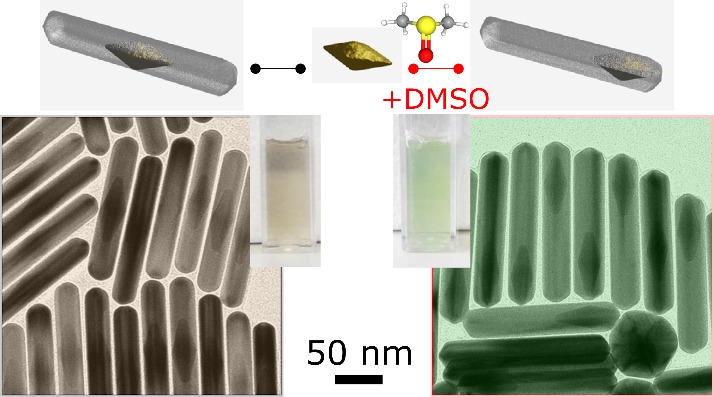 |
|
Engineering symmetry breaking in seed-mediated growth is a fundamental challenge to produce colloidal nanocrystals with controlled morphologies and properties. In this work, we show a simple, aqueous approach to breaking the inversion symmetry of silver nanorods by restricting growth to one end of the pentatwinned gold bipyramid seed. Controlled addition of dimethyl sulfoxide (DMSO) allows us to tune both the symmetry and the length and width of the objects. Simulations and experiments demonstrate the adsorption of DMSO, which displaces interfacial water, reduces binding of surfactant and chloride ions at the gold surface, and slows down the deposition kinetics of silver. Besides showing the potential of DMSO for controlling the synthesis of complex nanostructures, this work opens new perspectives for the study of the physical properties of non-centrosymmetric nanoparticles, e.g. by controlling their plasmon modes and their second-harmonic generation efficiency. |
Structure and Formation Kinetics of Millimeter-Size Single Domain Supercrystals
31/03/2021
https://doi.org/10.1002/adfm.202101869
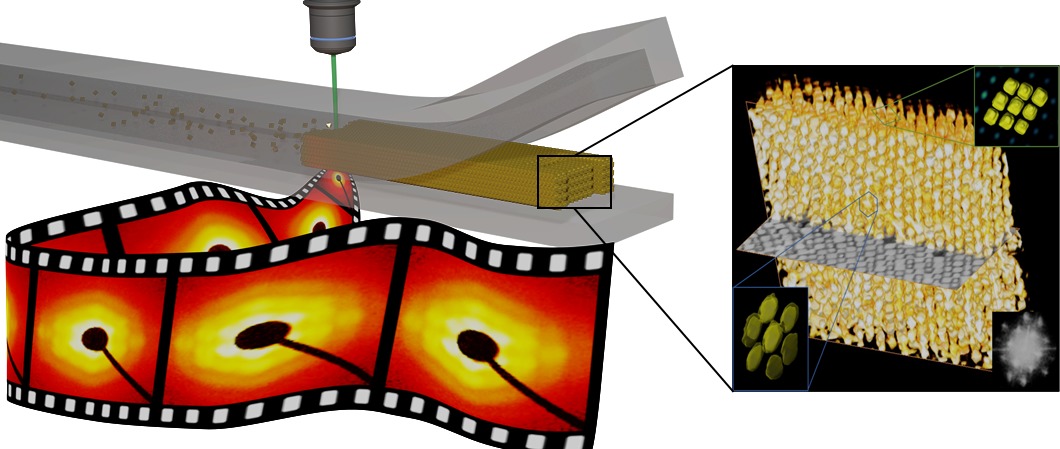 |
Organizing nanoparticles (NPs) into periodic structures is a central goal in materials science. Despite progress in the last decades, it is still challenging to produce macroscopic assemblies reliably. In this work, we report the analysis of the pervaporation-induced organization of gold octahedra into supercrystals within microfluidic channels using a combination of X-ray scattering techniques and FIB-SEM tomography. The results reveal the formation of a single-domain supercrystal with a monoclinic C2/m symmetry and long-range order extending over the dimensions of the microfluidic channel, covering at least 1.7x0.3 mm2. Time-resolved small angle X-ray scattering analysis showed that the formation of the superlattice involves an accumulation of the NPs within the channel before the nucleation and growth of the supercrystal. The orientation of the crystal remains unchanged during its formation, suggesting a growth mechanism directed by the channel interface. Together, these results show the potential application of the pervaporation strategy to providing spatially determined control over NP crystallization, which can be used for the rational fabrication of nanomaterial architectures.
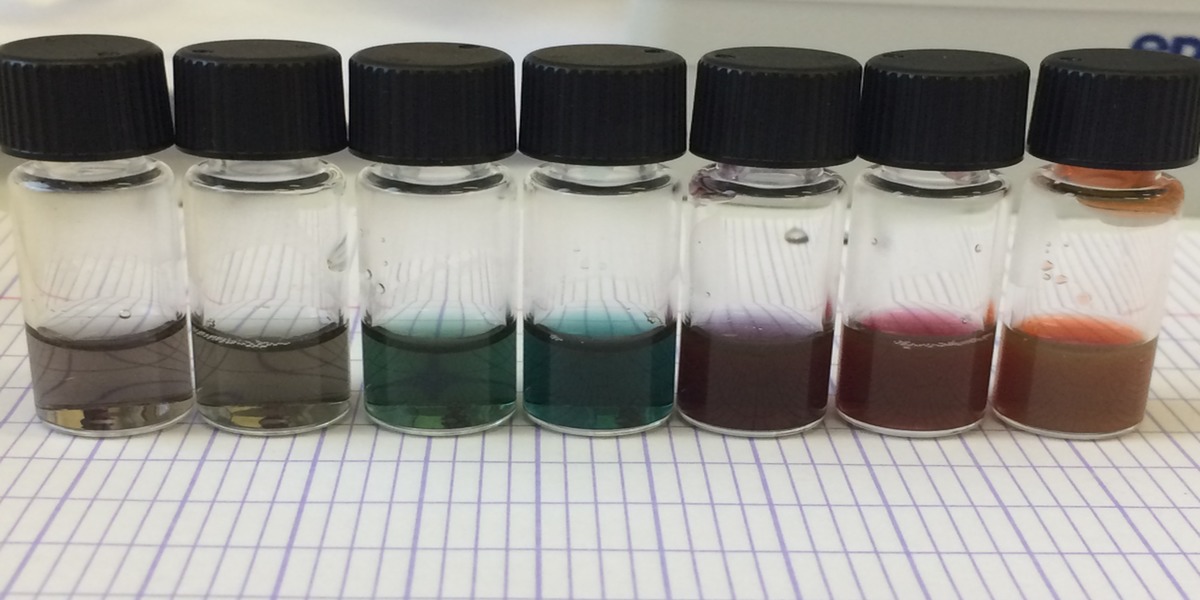
Plasmonic NPs Synthesis by colloidal chemistry
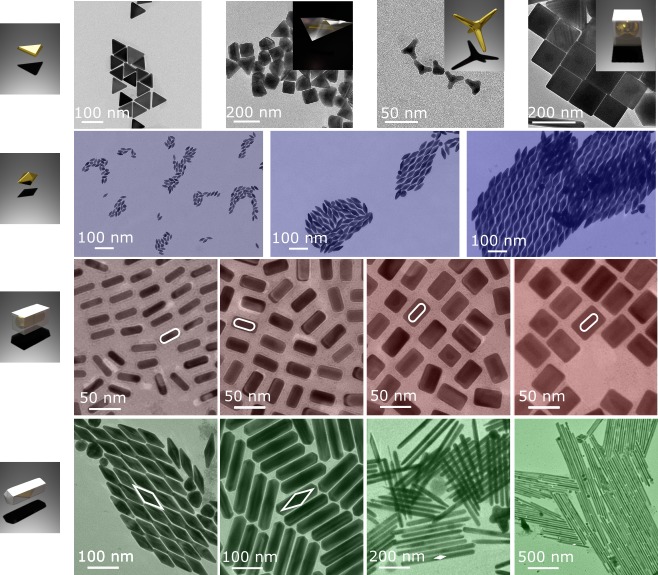 |
Selection of TEM images of Au or Au@Ag NPs with various morphology obtained in the team. The colors distinct series of nanocrystal: gold bipyramids of different size (purple), Au@Ag nanorods of varying shell thickness (red), Au@Ag bipyramids of varying shell length (green). |
Shaping nanomaterials
Construction of nanoscale devices is a crucial step toward the sucess of nanotechnologies in a variety of fields. Although construction by addition of individual building blocks might appear impossible without using nanomachines, it can actually be carried out by simply exploiting the different magnitude of attractive and repulsive interaction forces at the nanoscale. For example, gravity is negligible for nanoparticles, but other forces become dominant and require the nanoparticles to be coated with selected molecules. Thus, one can simply let the solvent evaporate and wait the nanoparticles to organize into ordered structures without any intervention. Such strategy is one of the core of the concept of self-assembly.
Gold and silver nanoparticles
Plasmonic nanoparticles (Au and Ag) have been object of fascination since ancient time for the preparation of stained glass. Such elementary building block are extremly robust and their use in monuments stand the test of time. A not too far example from the laboratory is the "Sainte-Chapelle du Palais" at "l'île de la cité" in Paris (see image, wikipédia). This phenomenon, commonly witnessed by everyone, originates from the plasmonic properties of metallic nanoparticles.

Optical properties of nanoparticles
The strong optical properties of nanoparticles (e.g. plasmonic or semiconducting) can be tuned across the visible to the mid infra-red range by modifying their size and shape. When such nanoparticles are organized in ensembles, collective properties are obtained that differ from those of individual particles and the resulting optical properties can be further tuned and even amplified. In particular, plasmon coupling in small gaps (1–10 nm) between plasmonic nanoparticles results in intense electric fields (i.e.,hot-spots) that can be exploited for many purposes, such as sensing, biomaterials, metamaterials design, switching devices, and so forth.
Use of light to study nanoparticles self assembly
We use UV/Vis spectrometry and X-ray scattering tecniques (SAXS) to study nanoparticles super-structures. The structural study of the material is the first step before understanding its overall properties and considering applications. SAXS is an experimental technique used to study the structural properties of materials and gives information on the size and orientation of the nanoparticles, their arrangement, the characteristic interdistances and the possible long-range organization. In a scattering experiment, ordered phases give diffraction signals that are called Bragg peaks. Analysis of such signals requires adapting standard methods of crystallography to the nanoscale, as the relevant length scale is much larger than the atomic scale. UV/Vis spectrometry is used complementary to measure the collective optical properties. Both techniques can be used in situ to study self assembly's pathways.
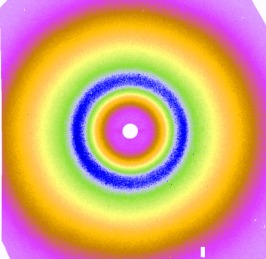
Mesoporous materials
A mesoporous material is a material containing pores with diameters between 2 and 50 nm. We are devising materials containing a mesoporous architecture to enhance size and shape selectivity for guest molecules or to template nanoparticles synthesis.
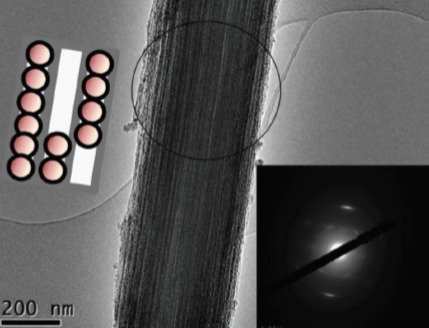
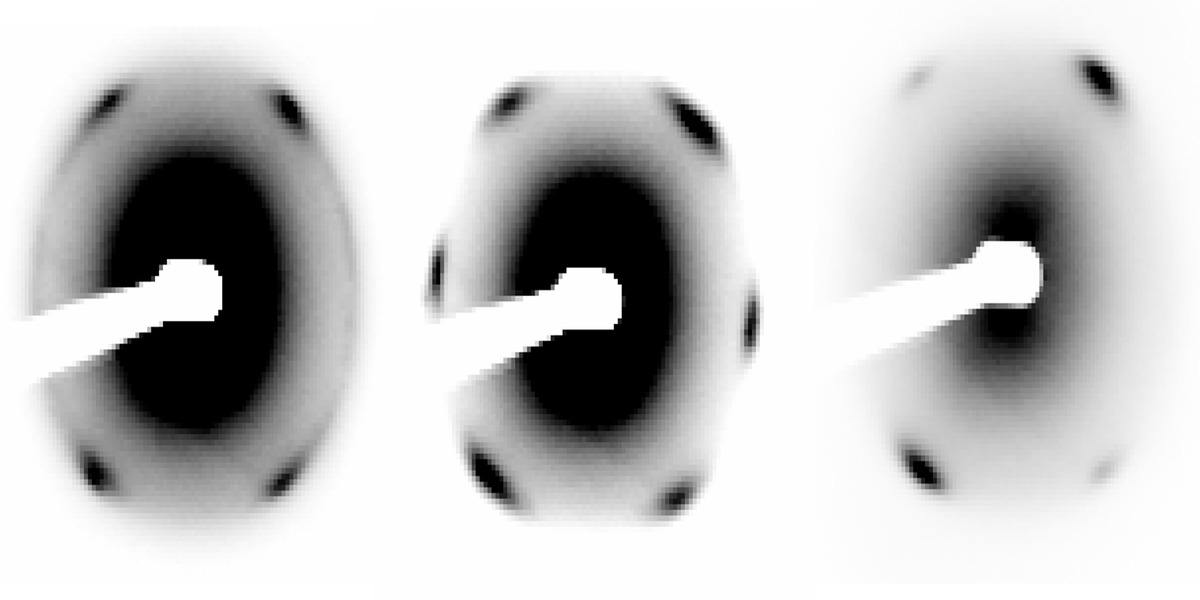
Team MATRIX
|
|
We are all working in the team MATRIX at the Laboratoire de Physique des Solides (LPS) in Orsay. The LPS is part of the vibrating Paris region fostering interaction with fellow researchers and visiting scientist.
LPS website: https://www2.lps.u-psud.fr/ MATRIX team website: https://equipes2.lps.u-psud.fr/matrix/ |
Cyrille Hamon
|
|
Cyrille Hamon obtained his Ph.D. from the University of Rennes 1 (France) under the supervision of Pascale Even-Hernandez and Valérie Marchi in 2013. He was a postdoctoral fellow in Luis Liz-Marzán laboratory (CIC Biomagune, Spain) from 2014 to 2016. He then joined the laboratories of Gaëlle Charron and Pascal Hersen (MSC, Université Paris 7) from 2016 to 2017. He has been appointed in 2017 with a permanent CNRS position in the Laboratoire de Physique des Solides in Orsay. His current interest focuses on devising new plasmonic architectures for sensing applications. |
Alumni
Wajdi Chaâbani - 2022
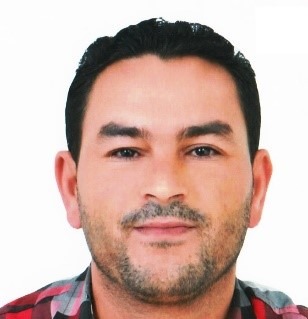 |
Wajdi Chaâbani obtained his Ph.D. from the University of Technology of Troyes (France) and the University of Sciences of Sfax (Sfax, Tunisie) under the supervisions of Jérôme Plain and of Abdallah Chehaidar in July 2019. He was a postdoctoral researcher in IEMN Laboratory (Lille, France) from September 2019 to August 2020. He then joined the Laboratoire de Physique des Solides in Orsay (France) as postdoctoral researcher. Currently, his interest focuses on self-assembling plasmonic nanoparticles in confinement. The nanostructuration will be resolved at the single supercrystal level using an innovative Small Angle X-ray Scattering (SAXS) setup developed on a synchrotron beamline.(SWING, @SOLEIL). He is now doing a postdoc at ITODYS (Université Paris-Cité) |
Jianan Qian - 2022
 |
I obtained my Bachelor of Engineering in Nano Materials and Technology from Soochow University in China. During my undergraduate study, I worked on several projects related to nanoscaled functional materials for energy conversion and storage under the supervision of Prof. Yanguang Li.
I am now the M2 student from Erasmus Mundus Joint Master program: SERP+. Currently, I am working on my thesis project about self-assembly of colloidal liquid crystal in levitation under the supervision of Dr. Cyrille Hamon and Dr. Erwan Paineau. |
Jieli Lyu - 2022
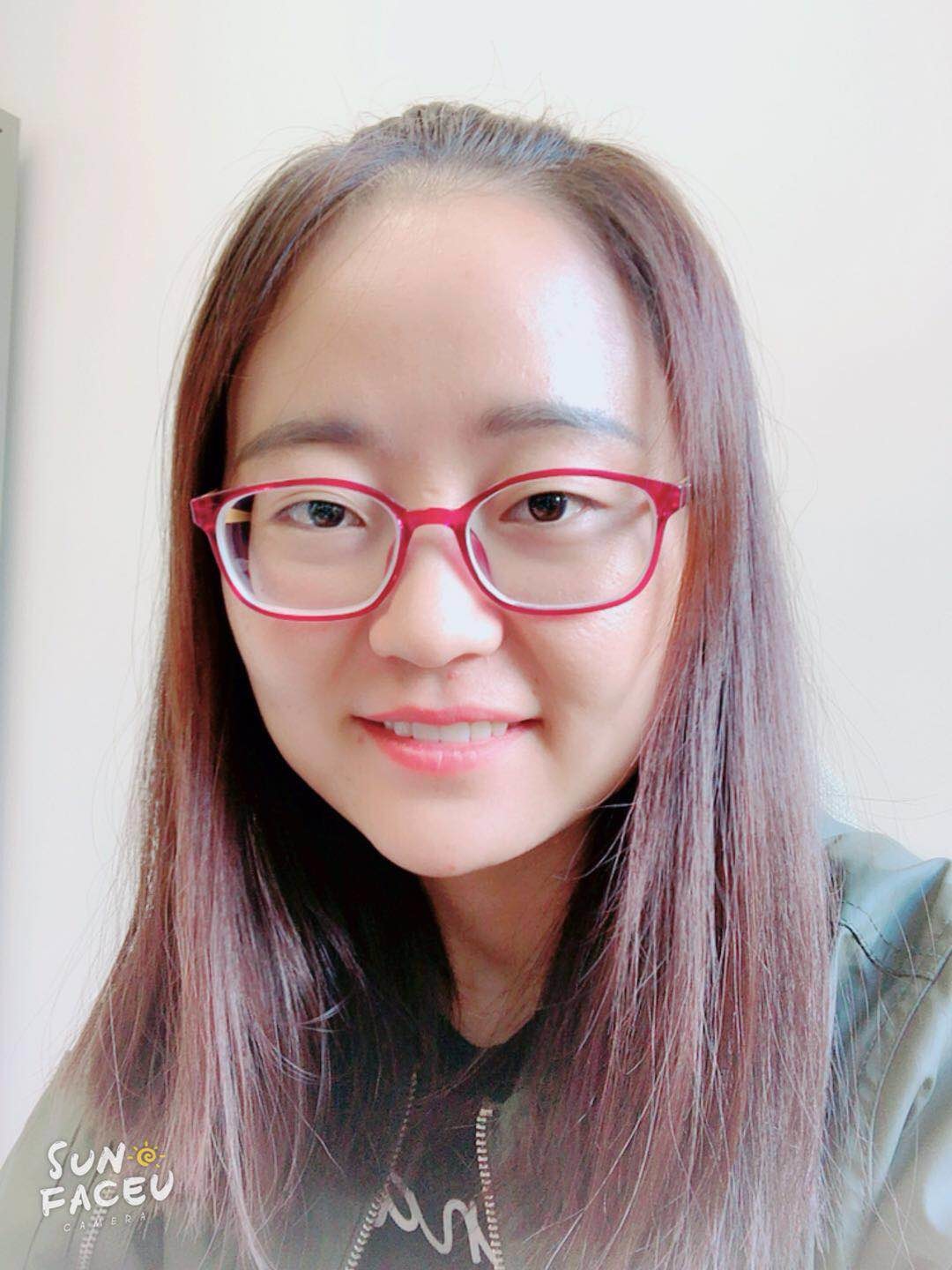 |
Jieli Lyu completed her M.S. degree at the Key Laboratory of Applied Surface and Colloid Chemistry of Shaanxi Normal University. She studied under the supervision of Prof. Junxia Peng and Prof. Yu Fang, and her main research topics were (1) synthesis and characterization of amphiliphic compounds; (2) formulation and performances of the emulsions; (3) emulsion-templated preparation of porous materials and their catalytic performance. She started her PhD in october 2018. Her research interest focuses on nanomaterials with a multiscale organization as well as shedding light on the self-assemblies pathways using light scattering techniques. |
Samantha Roque - 2021
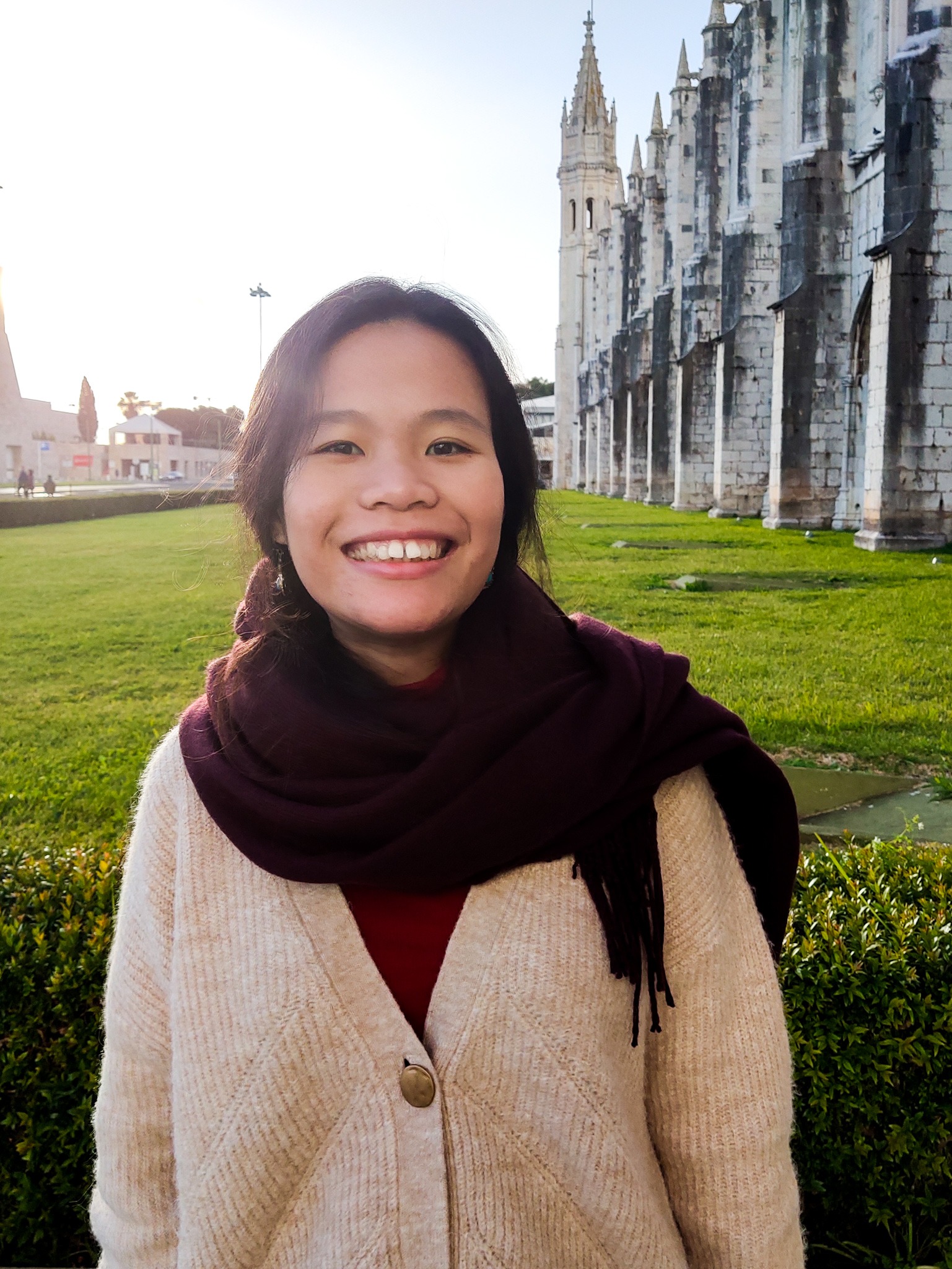 |
|
Masa Johar - 2021
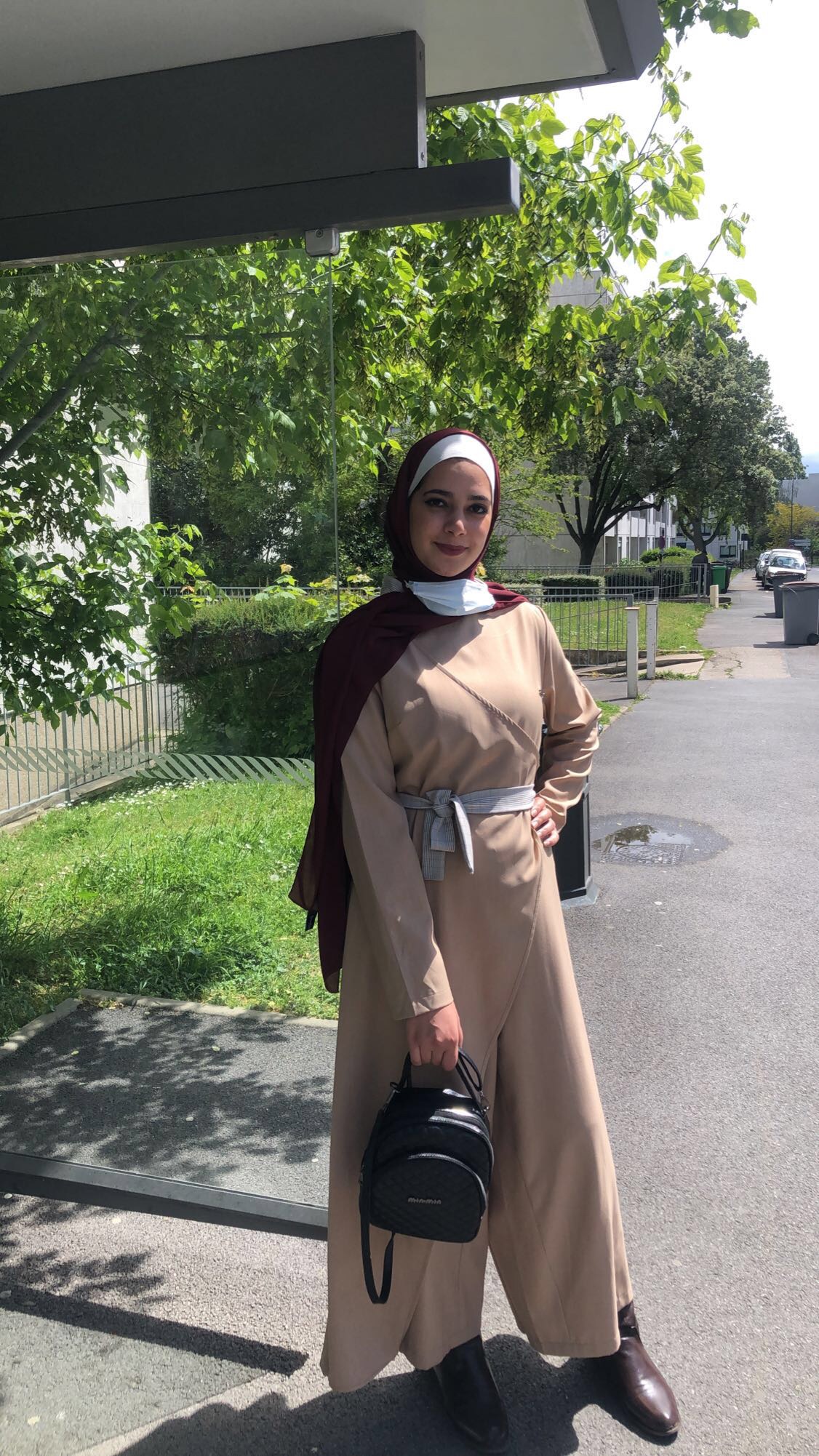 |
Masa Johar graduated from An-Najah National University, Palestine (2020), with a bachelor's degree in Applied Chemistry. She joined University of Paris Saclay in September 2020 to start her master's degree within the Chemistry International Track program for two years.
Currently, she is doing her M1 internship on "Colloidal chemistry of plasmonic triangular nanoplatelets" under supervision of Prof. Cyrille Hamon at the Laboratory of Solid Physics (LPS). Her main motivation is to find the best protocol for synthesizing triangular gold nanoparticles.
Finally, she is looking forward to being a highly skilled researcher enthusiastic about supporting advancements in the nanotechnology world, passionate about increasing knowledge to drive growth and needed improvements related to sustainable developments in Energy, Health and Environment.
She is now doing a PhD at Université Paris Saclay
|
Kinanti Aliyah - 2019
|
|
Kinanti Hantiyana Aliyah earned her Bachelor of Science in Chemistry from Tohoku University, Japan (2017). She worked in Institute for Materials Research for her bachelor thesis, under supervision of Prof. Hitoshi Miyasaka synthesizing novel building blocks for donor-acceptor metal-organic frameworks. Currently, she is in her second-year master Erasmus Mundus Joint Master Degree SERP+, working on thesis project about synthesis and characterization of anisotropic bimetallic nanoparticles in real time under supervision of Dr. Cyrille Hamon and Dr. Doru Constantin. Additionally, believing education should be accessible to all, she co-founded and actively maintains an online-based knowledge-sharing platform for Indonesians (ajarbelajar.com). Kinanti is now doing her PhD at the Paul Scherrer Institut (Switzerland) |
Nika Kutalia
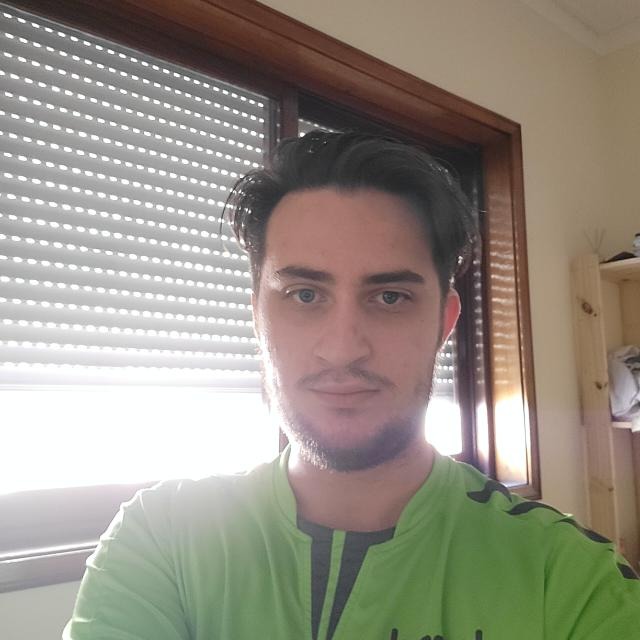 |
I started thinking about chemistry when I participated in international chemistry Olympiad, (ICHO) 48 where I became fascinated about science. Therefore, I studied chemistry at San Diego State University Georgia and obtained bachelor’s degree there. Then, I decided to divert study direction towards physical chemistry and materials science that is why I applied to SERP master program. Currently, I am involved in M2 internship in LPS where I work for the project “Templated Colloidal Crystals with Collective Optical or Magnetic Properties” which is supervised by Dr.Cyrille Hamon and Dr.Marianne Imperor-Clerc.
Currently, I am particularly interested in self-assembly of nanoparticles and how to utilize the properties of nanoparticles in the field of plasmonics/photonics and imaging. |
Jaime Gabriel Trazo
 |
Jaime Gabriel Trazo earned his bachelor degrees in Chemistry and in Materials Science and Engineering at the Ateneo de Manila University (2019, 2020), where he worked on formulating green silver nanoparticle inks for printed electronics and on nanocellulose synthesis, under Dr. Jose Mario Diaz and Dr. Erwin Enriquez. He was also a National Awardee at the BPI-DOST Science Awards 2019 in the Philippines.
He then pursued his master’s degree under the Erasmus Mundus SERP+ Program. For his M2 internship, he joined the Laboratoire de Physique des Solides, where he works on the self-assembly of nanoparticles into supercrystals with collective optical/magnetic properties, under Dr. Cyrille Hamon and Dr. Marianne Impéror-Clerc. He obtained a grant from the ED2-MIB doctoral school to continue the adventure at LPS in PhD. |
Rahul Nag
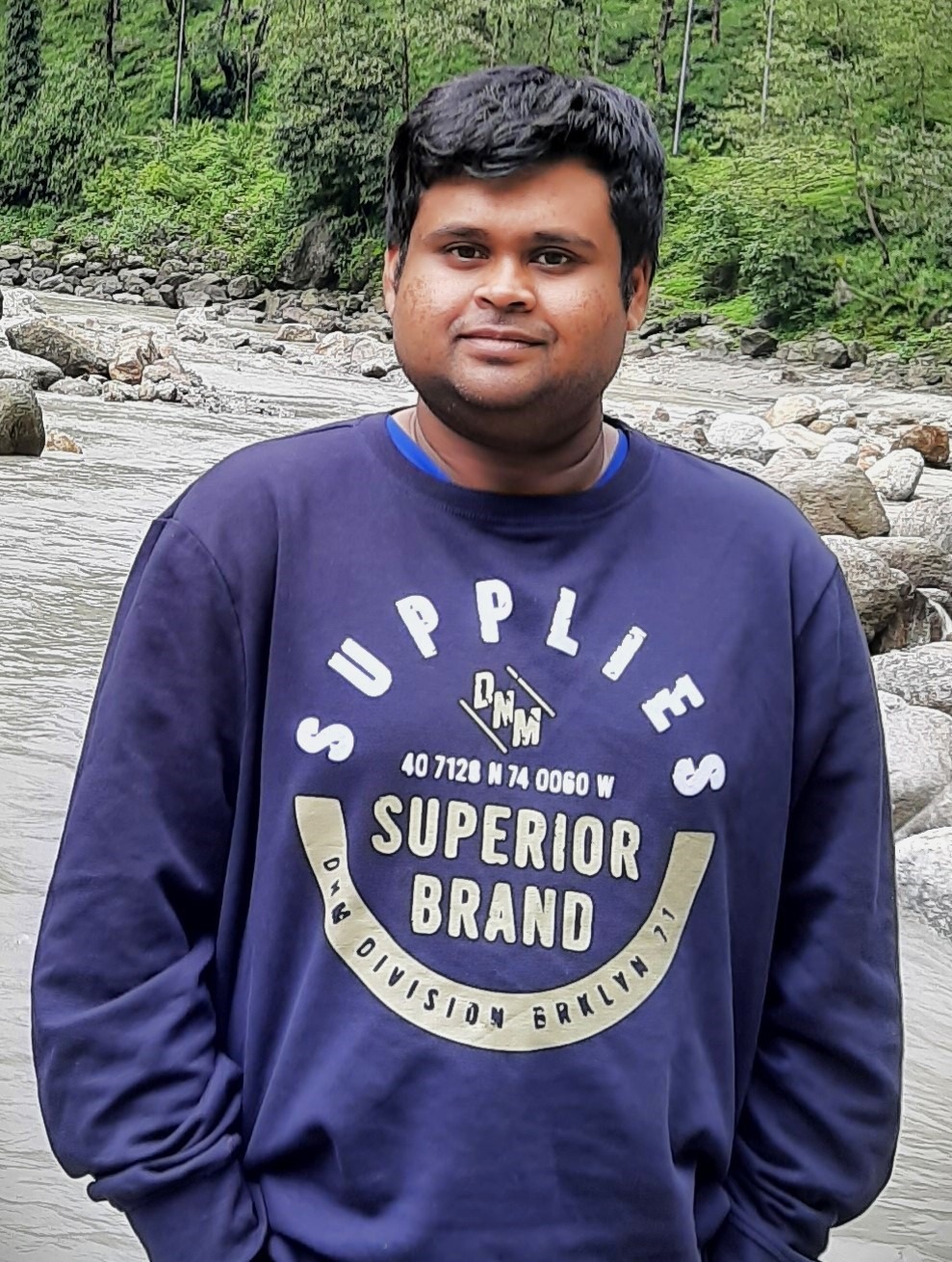 |
Rahul Nag obtained his PhD from IIT Bombay under the supervision of Chebrolu Pulla Rao in Bio-Inorganic Chemistry Laboratory. He worked on the surface functionalization of nanostructures by organic conjugates specially calixarenes which involved applications in sensing, cancer cell killing, catalysis. He did a one-year post-doctoral research in CBMN/University of Bordeaux under the supervision of Emilie Pouget in the Chiral Molecular Assemblies Group led by Reiko Oda. He is now joining the Laboratoire of Physique des Solides as a postdoctoral researcher with Cyrille Hamon. Currently, his interest focuses on the synthesis of gold nanostructures controlling their shapes and sizes for possible application in non-linear optics. |
Claire Hotton
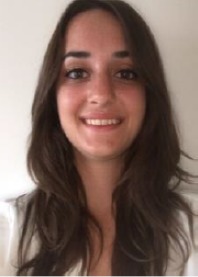 |
Claire Hotton obtained her PhD from Sorbonne University under the supervision of Natalie Malikova in PHENIX laboratory. She worked on the structure and properties of hydrogels based on ionene-type cationic polyelectrolytes and clay nanoplatelets.
She is now joining the Laboratoire of Physique des Solides as a postdoctoral researcher with Cyrille Hamon and Erwan Paineau. Currently, her interest focuses on the self-assembly of colloidal liquid crystals by acoustic levitation.
|
Jules Marcone
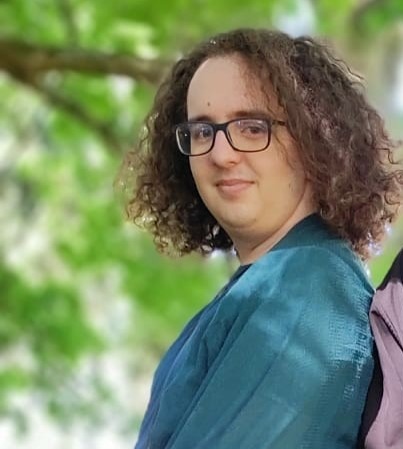 |
Jules Marcone graduated in 2022 from the Paris-Saclay University in 2022 with a Magister of Molecular Physicochemistry, focusing on Inorganic, Physical, and Materials Chemistry. During his study, he developed various skills in characterization methods (SAXS, XRD, SEM, etc.), and also in nanoparticle synthesis and self-assembly.
Jules started his PhD in October 2022 under the supervision of Marianne Impéror-Clerc and Cyrille Hamon at the LPS, on the synthesis and self-assembly of nanoparticles focusing particularly on cobalt nanorods, aiming for collective magnetic properties.
|
